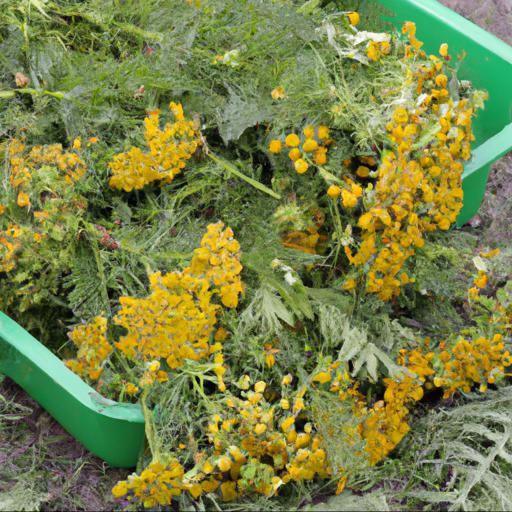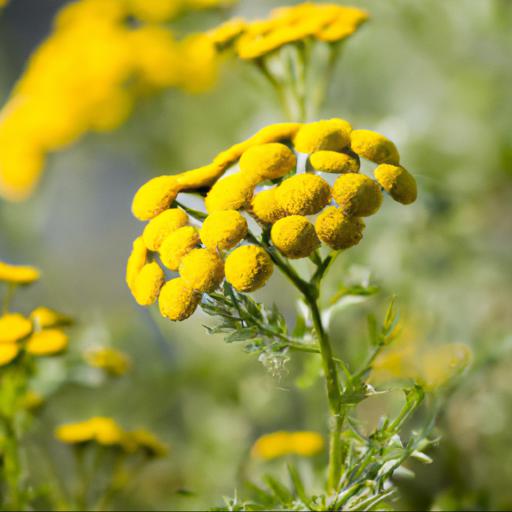Tanacetum vulgare, commonly known as Tansy, is a perennial flowering plant native to Europe and Asia. It has been used for centuries as a medicinal herb to treat a variety of ailments, from digestive issues to skin conditions. Tansy has also been used as an insect repellent, and as a flavoring agent in food and beverages.
In this blog, we will explore the history, uses, and health benefits of Tansy, as well as its potential side effects. We will also discuss how to use Tansy safely and effectively, and how to grow it in your own garden.
Finally, we will look at some of the different varieties of Tansy available.
Health benefits of tanacetum vulgare

Tanacetum vulgare, also known as common tansy, is a species of flowering plant native to Europe, Northern Africa, and Western Asia. Known for its yellow, button-like flowers and its scent, tansy is often used for culinary and medicinal purposes.
Whether you’re looking to spruce up your landscape with a splash of yellow or are looking for a functional herb for your well-being, tansy is a “super” garden plant. Tansy is an herb that grows to a height of three to five feet tall, with a wide spreading habit. When grown in gardens, it will produce a profusion of small, yellow, button-like flowers.
Its scent is quite strong, with a smell reminiscent of camphor or rosemary. The plant blooms from late summer through autumn, providing a long-lasting burst of color and scent to the garden.
The health benefits of tansy are numerous. It has been used as a homeopathic remedy to treat liver and kidney diseases, respiratory problems and anxiety. It can also be used as an herbal tea to aid digestion, reduce inflammation and heal wounds.
Applied topically, it can help remove warts and reduce hemorrhoids. Studies have also found that tansy can help fight cancer.
In addition, it has antifungal, antiviral and anti-inflammatory properties, which have been shown to be quite effective in controlling a variety of skin conditions. Although tansy has many beneficial properties, it is considered to be a toxic herb and should be treated with caution. If ingested, tansy can cause vomiting, nausea, and diarrhea and in some cases, it can be fatal if too much is consumed.
Therefore, it is best to consult a professional, such as a certified herbalist or doctor, prior to using, and never take tansy in large quantities. All in all, tansy is a great addition to any garden. Not only is it an attractive addition, it also has many medicinal properties that may just come in handy. Just make sure to use it wisely and to get the advice of an expert when necessary.
Uses of tanacetum vulgare

Tanacetum vulgare, commonly known as tansy, is a herbaceous perennial plant and a valuable garden asset. Originally found in Europe and Asia, it is now cultivated in many regions around the world, often for its attractive foliage display and attractive flower clusters. The plant has a long way in its traditional uses and has many benefits for home gardeners.
In traditional medicine, tansy has been noted for its medicinal, insecticidal and antiseptic properties. Historically, it has been used to treat a variety of ailments and diseases, as well as expelling parasitic worms and stimulating the appetite.
Through modern research, we’ve learned that this plant contains many compounds, such as polyphenols, which possess powerful antioxidant, anti-inflammatory and anti-cancer properties. When planting tansy in the garden, it’s important to keep in mind that the plant can spread quickly, so it is advisable to have it in its own bed or in a pot. Additionally, the plant can be used as a companion plant to repel invading pests, since its strong scent deters many bugs.
Furthermore, its flower heads are often employed to make lovely floral arrangements and bouquets. In particular, its profuse yellow flowers provide an impressive display from summer until fall.
Additionally, it is also a great addition to wildflower gardens, bringing a touch of lacy beauty. Therefore, Tanacetum vulgare is a beautiful, yet useful garden plant that that holds many potential benefits for home gardeners. Whether it be used for medicinal purposes, as an insect repellent, for decorative purposed, or simply for the sheer beauty it brings the garden, it’s an ideal choice for any gardener looking to add diversity to their garden.
Moreover, it is an easily manageable plant to care for.
Growing and harvesting tanacetum vulgare

Tanacetum vulgare – otherwise known as Garden Tansy – is a hardy perennial herb with a history of use in traditional medicine. It is a hardy, drought-resistant plant that is easy to grow and can be grown in nearly any soil conditions.
It has a strong and assertive flavor that has been an important addition to herbal medicines and food dishes since medieval times. It has small, button-like yellow flowers that appear during late summer and have a distinctive aroma. In the home garden, Tanacetum vulgare can be grown from seeds or cuttings, or planted in containers.
If you’re growing it from seed, you’ll need to chill the seeds before planting. For those planting in containers, well-drained, fertile soil and full sunlight are preferable.
Watering the plant frequently but not to excess will help it to thrive. This herb may also spread, so it’s best to contain it or remove the flower heads before they spread. Harvesting Tanacetum vulgare is done at the end of summer when the flower heads have developed.
The flower heads contain both the flower and the essential oils found in the herb. Once harvested, the flower heads can be dried or infused into oil or alcohol for making a tincture.
The dried flower heads can be used to make tea, medicines and food dishes. The essential oils in the flower heads are also great for steam inhalation, when used in a diffuser, or when added to a bath. Ultimately, Tanacetum vulgare is an easy-to-grow, drought-hardy herb that produces fragrant and flavorful yellow blooms and is packed with essential oils.
With its versatile medicinal, culinary, and decorative uses, it is a great addition to the garden. For those who’d like to experience the benefits of this magical herb, growing and harvesting Tanacetum vulgare can be a wonderful and rewarding experience.
Recipes using tanacetum vulgare
Grown in gardens across the UK, Tanacetum vulgare is an incredible herb that has been used for a variety of culinary and medicinal purposes. In addition to its detoxifying properties and multiple medicinal uses, tanacetum vulgare also can be used as a flavoring agent in a wide range of recipes.
Whether you’re looking for a fragrant addition to a hearty stew or just a little something special for dessert, tanacetum vulgare is the perfect ingredient for cooking up something delicious. For starters, a healthy and tasty salad using tansy is easy to prepare. Simply take some fresh leaves of tanacetum vulgare, wash thoroughly and dry with a paper towel.
Then, toss the leaves with your favorite dressing – perhaps a vinaigrette – along with a few other ingredients such as cooked grains, chopped nuts, sliced apples and a handful of your favorite herbs. The result is a simple yet flavorful salad that will make a great lunch or side dish.
For those who prefer a bit more adventure in their cooking, tanacetum vulgare can provide the perfect flavor balance in a rich, flavorful stew. Start by sautéing some onions, garlic and other vegetables in olive oil until they’re softened and lightly browned. Then add in some diced tomatoes, carrots and other vegetables of your choice.
Finish it off with some stock and tansy, bring it all to a steady simmer and allow it to cook for about an hour until you have a delicious and hearty stew. Serve it over a bed of couscous or mashed potatoes and enjoy.
For a sweet finish, top off your meal with a light and creamy dessert using a few tablespoons of tanacetum vulgare. Begin by grating the tansy leaves and steeping them in hot milk for about 20 minutes. Then, strain the milk and discard the leaves, add in some sugar and whip the cooled milk along with a few tablespoons of your favorite flavored liqueur, such as Frangelico.
Serve it over a few scoops of your favorite vanilla ice cream. No matter whether you’re looking for a healthy starter to your meal or something special for dessert, tanacetum vulgare is a flavorful herb that can take your cooking to the next level. Try it out in these recipes and enjoy the unique flavor and health benefits tanacetum vulgare has to offer.
Our video recommendation
Bottom Line
Tanacetum vulgare, commonly known as tansy, is a flowering plant native to Europe and Asia. It has been used for centuries as a medicinal herb to treat a variety of conditions, including digestive disorders, fevers, and skin problems. It is also used as an insect repellent and can be added to food as a flavoring.
Tansy is a hardy plant that requires little care and can be grown in many climates. However, it can be toxic if ingested in large amounts, so caution should be taken when using it.
FAQ
What are the medicinal uses of Tanacetum vulgare?
Tanacetum vulgare, commonly known as tansy, has been used medicinally for centuries. Its medicinal uses include treating digestive problems, reducing inflammation, and relieving pain. It is also used to treat fever, headaches, and skin conditions such as eczema. Additionally, tansy has been used to treat menstrual cramps, reduce anxiety, and improve circulation.
What are the common names for Tanacetum vulgare?
Common names for Tanacetum vulgare include common tansy, bitter buttons, cow bitter, and golden buttons.
What is the scientific classification of Tanacetum vulgare?
The scientific classification of Tanacetum vulgare is Asteraceae, Anthemideae, Tanacetum, Tanacetum vulgare.
What are the chemical constituents of Tanacetum vulgare?
The chemical constituents of Tanacetum vulgare include terpenes, flavonoids, phenolic acids, tannins, and essential oils.
How is Tanacetum vulgare used in traditional medicine?
Tanacetum vulgare, also known as tansy, has been used in traditional medicine for centuries. It is believed to have anti-inflammatory, antispasmodic, diuretic, and antiseptic properties, and is used to treat digestive issues, headaches, and skin conditions such as eczema. It is also used as an insect repellent and to treat fever and menstrual cramps.
What are the potential side effects of using Tanacetum vulgare?
The potential side effects of using Tanacetum vulgare include nausea, vomiting, diarrhea, abdominal pain, headache, dizziness, and skin rash. It may also cause allergic reactions in some people.

